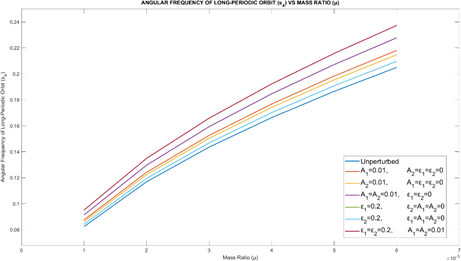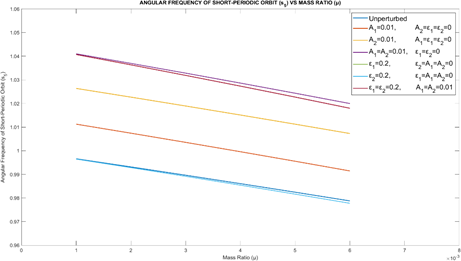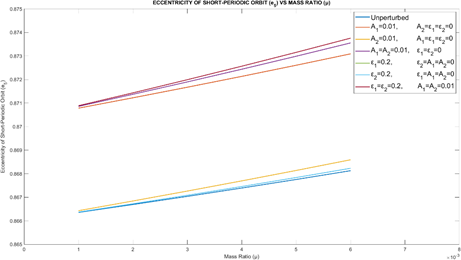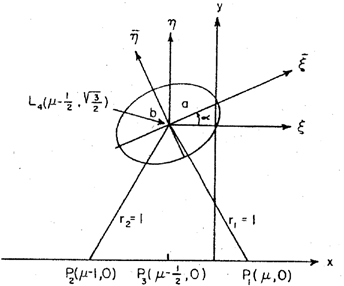From Newton to Lagrange, the restricted three-body problem caught the curiosity of many mathematicians and astronomers in the early days of its development. The applications of the restricted three-body problem to celestial mechanics have formed the basis of certain lunar and planetary theories in recent years, with the launch of artificial satellites in the Earth-Moon system and in the solar system. Euler was the first to contribute to the restricted three-body problem in 1772. The theory of restricted three-body problem begins with Euler and Lagrange in 1772 and continues with Jacobi in 1836, Hill in 1878, Brown in 1896, Poincare in 1892, Levi-Civita in 1904, Birkoff in 1915, and many more current mathematicians and astronomers.6 Two bodies of masses m1 and m2 revolve around their centre of mass (barycentre) in circular orbits under the influence of their mutual gravitational attraction and a third body of mass m3 attracted by the previous two bodies moves in a plane defined by the two revolving bodies. Here, the other two bodies are considerably having more mass than the third body (the mass of the third body is considered to be negligible and not in comparable with the other two heavier bodies). Since, the mass of the third body is restricted here; it will not influence the motion of other two revolving bodies. The two revolving bodies are called the primaries; they are also called as massive and smaller primaries, in accordance with their masses. The restricted three-body problem is to study the motion of third body around the primaries.
Sharma and Subba Rao7-9 studied the restricted three-body problem by considering the more massive primary as an oblate spheroid with its equatorial plane coincident with the plane of motion by considering the secular effect of oblateness on mean motion.10 Sharma11 studies the restricted three-body problem by considering the more massive primary as an oblate spheroid as well as source of radiation. Sharma12 studies the restricted three-body problem by considering the more massive primary as a source of radiation and smaller primary as an oblate spheroid. Both the above studies used the mean motion of Subba Rao and Sharma.10 Many more studies were done with this mean motion expression literature.
Singh and Ishwar2 studied the effect of oblateness and radiation pressure of both the primaries on the location and linear stability of the triangular points in the restricted three-body problem using the above mean motion expression. They derived a series expression for critical mass μc. Subba Rao and Sharma13 studied the effect of oblateness of the more massive primary on the non-linear stability of L4 in the restricted three-body problem.
AbdulRaheem and Singh14 studied the combined effects of perturbations on the stability of equilibrium points in the restricted three-body problem. They investigated the perturbations due to small Coriolis and centrifugal forces, as well as the effects of oblateness and radiation pressure of the primaries for the equilibrium points. They calculated the critical mass by including all the perturbations. AbdulRaheem and Singh15 studied the effects of radiation and oblateness on the periodic orbits in the restricted three-body problem. Effect of Coriolis and centrifugal forces was also considered. Abouelmagd and El-Shaboury3 analyzed the periodic orbits under the combined effect of oblateness of three bodies and radiation pressure of both the primaries in circular restricted three-body problem. They calculated and plotted the variations of angular frequencies for perturbed and unperturbed cases with the mass ratio. Abouelmagd16 studied the linear stability of the triangular points with oblateness and radiation pressure in the restricted three-body problem. A series expression for critical mass μc is found. Ansari and Alam17 studied the circular restricted three body problem by considering one of the primaries as oblate and other one having the solar radiation pressure and all the masses are variable. They found that all the equilibrium points are linearly unstable. Khalifa18 carried out a semi-analytical study of the effect of ground-based laser radiation pressure on the location of triangular points in the framework of the planar circular restricted three-body problem. Jency et al.5 studied the stationary solutions, critical mass, tadpole orbits in the circular restricted three-body problem, where the massive primary is considered as an oblate spheroid. The authors utilized the new mean motion which included the secular effects of the oblateness of the primary on mean anomaly (M), the argument of perigee (ω), and right ascension of ascending node (Ω).1 They found the critical mass value μc to decrease further, which was compared with the μc value obtained by Subba Rao and Sharma.10 They further calculated the angular frequencies of long- and short-periodic orbits. They also computed the angle between the two coordinate systems.
Arohan and Sharma4 utilized the new mean motion expression to study the stationary solutions of the planar circular restricted three-body problem when the more massive primary is a source of radiation and the smaller primary is an oblate spheroid with its equatorial plane coincident with the plane of motion. Locations of the Lagrangian points were found and an expression for critical mass μc was obtained in the series form. John and Sharma19 studied the circular restricted three body problem by considering with the more massive primary as an oblate spheroid and source of radiation by using the new mean motion expression. The locations of the collinear Lagrangian points are found. The variations of the location of the Lagrangian points due to the unperturbed as well as the perturbed problem due to oblateness and radiation pressure were studied. A study on the eccentricity e and angular frequency s at the collinear points was carried out. Kumar et al.20 utilized the new mean motion by considering both the primaries as oblate spheroids with their equatorial planes coincident with the plane of motion. They studied the stability of the equilibrium points and observed that the collinear equilibrium points are always unstable. However, the non-collinear equilibrium points are stable for some combinations of the involved parameters. They plotted the zero velocity curves of the infinitesimal body for different values of the Jacobi constant C and oblateness parameters. It was observed that the value of C played a vital role in obtaining the permissible regions of motion of the infinitesimal body.
In our study, we have considered both the primaries as oblate spheroids and source of radiation in the planar circular restricted three-body problem. We have utilized the newly derived mean motion by Sharma et al.1 We have studied the effects of oblateness and radiation pressure of both the primaries on the critical mass ratio μc. We have also studied the variations of angular frequencies of long- and short periodic orbits at L4 with mass ratio μ. We have further studied the variation of eccentricities and time periods of long- and short periodic orbits around L4 with mass ratio. We have also generated an expression in series form for the angle α between the fixed and rotating coordinate system at L4. We have compared our results with other authors wherever possible. There are few new results in our study.
Equations of motion
We consider the two bodies called primaries of larger mass (m1) and smaller mass (m2) moving about their centre of mass in circular orbits in a plane (Figure 1). The third body of infinitesimal mass at point (P), which does not affect the motion of m1 and m2, is moving under their gravitational influence in the same plane. The origin of the system lies on the barycentre (centre of mass) of the primaries. r1 and r2 are the distances of the third body P from the more massive (m1) and the smaller (m2) primaries, respectively.
The equations of motion are given as
(1)
(2)
The force function Ω is given by:
, (3)
where q1 and q2 are the mass reduction factors with respect to m1 and m2, constant for the particle, with qi=1 – εi(i = 1, 2).εi are the ratio of radiation pressure forces to the gravitational forces [i.e., εi = FPi/Fgi].
,are the mass ratios for the two masses (m1) and (m2), respectively.μ1+ μ2 = 1, If μ2 = μ, then μ1 = 1 – μ, Ai = (AEi2 –APi2)/5R2, (i =1, 2). AE1 and AE2 are the equatorial radii of the more massive and smaller primary, respectively. AP1 and AP2 are the polar radii of the more massive and smaller primary, respectively. R is the distance between the primaries. A1 and A2 are oblateness coefficients of the more massive and smaller primaries, respectively.
The distances (r1) and (r2) of the third body from the two primaries (m1) and (m2), respectively, in the rotating coordinate system are given by
, (4)
, (5)
(6)
. (7)
are partial derivatives of Ω w.r.t. x and y, respectively.
Mean motion
Following Sharma and Subba Rao,7 AbdulRaheemand and Singh14 and Singh and Ishwar2 and others had used the mean motion (n) as:
. (8)
Sharma et al.1 derived another expression of mean motion by including the secular effects of oblateness on mean anomaly (M), argument of perigee (ω) and right ascension of ascending node (Ω) as (for inclination i = 0 degrees):
(9)
Using the relationship,
in Eq.(9)and averaging over one revolution:
(10)
(11)
(12)
we obtain
(13)
Pseudo mean motion including the precession effect due to oblateness in view of Eq. (13) is calculated as:
(14)
which gives ñ = 1 for unperturbed case.
When the value of eccentricity e becomes zero, we get n = ñ = 1 + 3A1R2/(a2Re2), which upon non-dimensionalizing gives.1,5
n = 1 + 3 A1. (15)
n2 = 1 + 6 A1, restricting to only first-order terms in A1. (16)
In our problem both the primaries are considered as oblate spheroids. So, we consider the mean motion as:
(17)
This mean motion is also used by Jency et al.,5 Arohan and Sharma,4 John and Sharma19 and Kumar et al.20
Location of triangular equilibrium points
The location of the triangular points is found from the following two equations for y≠0:
(18)
Equation (18) can be written in terms of equation (19) and (20) as:
(19)
(20)
We note for y≠0 in equation (20) and only second term is zero.
Following Singh and Ishwar,2 (19) and (20) can be written as
(21)
(22)
Substituting
(23)
(24)
and
(25)
(26)
Substituting(25) and (26) in (4) and (5) and noting that perturbation terms α and β << 1so that the higher order terms of α and β are neglected, we solve for x and y in terms of α and β and obtain:
(27)
(28)
Substituting (17), (23), (24), (25) and (26) in (21) and (22) and solving for α and β with MAXIMA21 software, we obtain
(29)
. (30)
Substituting (29) and (30) in (27) and (28) and simplifying, we get
(31)
(32)
The values of A1 and A2 are different in y in (32) from those of Singh and Ishwar2 due to different value of mean motion n.
For the unperturbed case, (31) and (32) become
(33)
(34)
which matches with the case of unperturbed restricted three-body problem.
Stability of the triangular points
At the triangular point L4:
(35)
(36)
(37)
The characteristic equation is
(38)
Substituting (35), (36), (37) in (38) and simplifying with the help of MAXIMA, we get
(39)
Substituting Λ = λ2, in equation (39), we get this
(40)
Solving the quadratic equation (40), we get the roots in the form:
(41)
(42)
Simplifying (41) and (42) in series form with MAXIMA21 and retaining the linear terms in A1, A2,
and,
we get
(43)
(44)
Critical mass ratio
Taking the discriminant D in (40) and after simplification, we get
(45)
Equating D = 0 and solving Eq. (45), we get two values of the mass ratio: (μ)
(46)
(47)
(μc) in the range [0, ½]. The triangular points are linearly stable for the mass parameter 0 ≤ μ <μc). After simplifications with MAXIMA21 and retaining first-order terms in A1, A2, ε1 and ε2, we get
(48)
(49)
The expression for
up to first-order terms in A1, A2, ε1 and ε2, obtained by Singh and Ishwar2 is
. (50)
or
(51)
From (49) and (51), we notice that with the new mean motion, the value of the critical mass μc further decreases.
It may be noted that the first two terms of critical mass ratio
in equation (49) match with Jency et al.,5 who utilize the same expression of mean motion as used here by considering the more massive primary as an oblate spheroid. It may also be pointed out that the critical mass ratio
obtained by Arohan and Sharma4 with the same mean motion expression by considering the smaller primary as an oblate spheroid does not match with our result here. They get the term 0.1194 A2 in the critical mass expression
i.e., it increases with oblateness of the smaller primary. However, our term with ε1 matched with the ε term of Arohan and Sharma.4
We conclude from the present study that the critical mass value
further decreases with oblateness with the new mean motion n when both the primaries are considered as oblate spheroids.
Periodic orbits
Angular frequencies
The angular frequencies can be calculated using the following relations
for long-periodic (S4) and short-periodic (S3) orbits around L4, respectively.
(52)
(53)
Substituting (43) and (44) in (52) and (53), respectively, we have
(54)
(55)
Simplifying (54) and (55) with MAXIMA in terms of a series up to third-order terms in μ, we get
(56)
(57)
It may be noted that s4 in (56) increases with oblateness (A1 and A2) and radiation pressure (ε1and ε2). It may also be noted that the unperturbed values in s4 in (56) match with the unperturbed expression in Sharma and Subba Rao.8
The A1 values in (56) match with the expression obtained by Jency et al.5 Similarly, the unperturbed values in s5 in (57) match with the unperturbed expression in Sharma and Subba Rao. The A1 values in (57) match with the expression obtained by Jency et al.5
Table 1 provides the variation of the angular frequencies (s4) and (s5) for mass ratioμ = 0.001 with different perturbations in A1, A2, ε1 and ε2. It may be noted that s4 increases with all the 4 perturbations. s5 decreases with radiation pressure perturbations ε1 and ε2. Figure 2 provided the angular frequency of the long- periodic orbits (s4) vs. Mass ratio μ for different values of perturbations. It is observed that s4 increases with the increase in μ for different cases of perturbations in A1, A2, ε1 and ε2.

Figure 1 Planar Restricted Three Body Problem in the fixed (sidereal) and rotating (synodic) coordinate system.

Figure 2 Angular frequency of the long-periodic orbits (s4) vs.mass ratio (μ).
|
μ
|
A1
|
A2
|
ε1
|
ε2
|
s4
|
s5
|
|
0.001
|
0
|
0
|
0
|
0
|
0.08239748223039
|
0.99659954596019
|
|
0.001
|
0.01
|
0
|
0
|
0
|
0.08750387289113
|
1.01124358864239
|
|
0.001
|
0
|
0.01
|
0
|
0
|
0.08625340301905
|
1.02636805425057
|
|
0.001
|
0.01
|
0.01
|
0
|
0
|
0.09135979367980
|
1.04101209693277
|
|
0.001
|
0
|
0
|
0.2
|
0
|
0.08424114003707
|
0.99644711487401
|
|
0.001
|
0
|
0
|
0
|
0.2
|
0.08424114003707
|
0.99644711487401
|
|
0.001
|
0.01
|
0.01
|
0.2
|
0.2
|
0.09504710929316
|
1.04070723476039
|
Table 1 Variation of angular frequencies (s4) and (s5) with mass ratio and perturbations
Figure 3 provided the angular frequency of the short- periodic orbits (s5) vs. Mass ratio μ for different values of perturbations. It is observed that s5 decreases with the increase in μ for different cases of perturbations in A1, A2, ε1 and ε2.

Figure 3Angular frequency of the short-periodic orbits (s5) vs.mass ratio (μ).
Eccentricities
The eccentricities of the long-periodic and short-periodic orbits around L4 are given by
(58)
By substituting the corresponding angular frequencies,
and
in Eq.(58) and simplifying in series form with MAXIMA,21 we get the corresponding eccentricities (e4) and (e5) of the long- and short-periodic orbits, respectively.
The eccentricity of long-periodic orbits (e4) is:
(59)
The eccentricity of short-periodic orbits (e5) is:
(60)
The series expansion expressions for e4 and e5 in (59) and (60) are new results. It is noticed that e4 decreases with the increase in the perturbations A1, A2, ε1 and ε2. And e5 increases with the increase in the perturbations A1, A2, ε1 and ε2.
Table 2 provides the variation of the eccentricities (e4) and (e5) for mass ratio μ = 0.001 with different perturbations in A1, A2, ε1 and ε2. It may be noted that e4 decreases with all the 4 perturbations. e5 increases with all the 4 perturbations.
|
μ
|
A1
|
A2
|
ε1
|
ε2
|
e4
|
e5
|
|
0.001
|
0
|
0
|
0
|
0
|
0.99849410844902
|
0.86635409957208
|
|
0.001
|
0.01
|
0
|
0
|
0
|
0.99837523103377
|
0.87078424670792
|
|
0.001
|
0
|
0.01
|
0
|
0
|
0.99839829151767
|
0.86642826289636
|
|
0.001
|
0.01
|
0.01
|
0
|
0
|
0.99827941410242
|
0.87085841003220
|
|
0.001
|
0
|
0
|
0.2
|
0
|
0.99842684719009
|
0.86636890071932
|
|
0.001
|
0
|
0
|
0
|
0.2
|
0.99842684719009
|
0.86636890071932
|
|
0.001
|
0.01
|
0.01
|
0.2
|
0.2
|
0.99814489158457
|
0.87088801232669
|
Table 2 Variation of eccentricities (e4) and (e5) with mass ratio and perturbations
Figure 4 provides the eccentricity of the long- periodic orbits (e4) vs. Mass ratio μ for different values of perturbations. It is observed that e4decreases with the increase in the mass ratio (μ) for different cases of perturbations in A1, A2, ε1 and ε2.

Figure 4 Eccentricity of the long-periodic orbits (e4) vs.Mass ratio (μ).
Figure 5 provides the eccentricity of the short- periodic orbits (e5) vs. Mass ratio μ for different values of perturbations. It is observed that e5increases with the increase in the mass ratio (μ) for different cases of perturbations in A1, A2, ε1 and ε2.

Figure 5 Eccentricity of the short-periodic orbits (e5) vs.Mass ratio (μ).
Time periods
Time periods of the long-periodic (T4) and short-periodic (T5) orbits around L4 are given respectively
(61)
(62)
Table 3 provides the variation of the time periods (T4) and (T5) for mass ratio μ = 0.001 with different perturbations in A1, A2, ε1 and ε2. It may be noted that T4 decreases with all the 4 perturbations, while T5 decreases with oblateness of the primaries and increases with radiation pressure perturbations ε1 and ε2. As seen in the last line over all it decreases significantly, showing the dominance of oblateness.
|
μ
|
A1
|
A2
|
ε1
|
ε2
|
T4
|
T5
|
|
0.001
|
0
|
0
|
0
|
0
|
76.25457886700097
|
6.304623890959079
|
|
0.001
|
0.01
|
0
|
0
|
0
|
71.80465389225638
|
6.213325234145472
|
|
0.001
|
0
|
0.01
|
0
|
0
|
72.84565115409855
|
6.121766242780639
|
|
0.001
|
0.01
|
0.01
|
0
|
0
|
68.77407505101253
|
6.035650618943157
|
|
0.001
|
0
|
0
|
0.2
|
0
|
74.58571078708923
|
6.305588338196981
|
|
0.001
|
0
|
0
|
0
|
0.2
|
74.58571078708923
|
6.305588338196981
|
|
0.001
|
0.01
|
0.01
|
0.2
|
0.2
|
66.10601157579605
|
6.037418687327769
|
Table 3 Variation of Time-Periods (T4) and (T5) with mass ratio and perturbations
Angle α:
(Figure 6) where α is the angle between the rotating and the fixed coordinate system.

Figure 6 Fixed and Rotating coordinate system at L4.6
The angle α given by
(63)
Substituting (35), (36) and (37) in (63) and simplifying with MAXIMA, we get
(64)
Simplifying (64) with MAXIMA, we get
(65)
Eq. (65) shows that α increases with oblateness and decreases with radiation force of the more massive primary and increases with the radiation force of the smaller primary. It is noticed that our expression of tan2α matches with that of Jency et al.5 for A1 term. Our results of tan2α do not match with ε1 and ε2 terms with that of Abouelmagd and El-Shaboury.3




